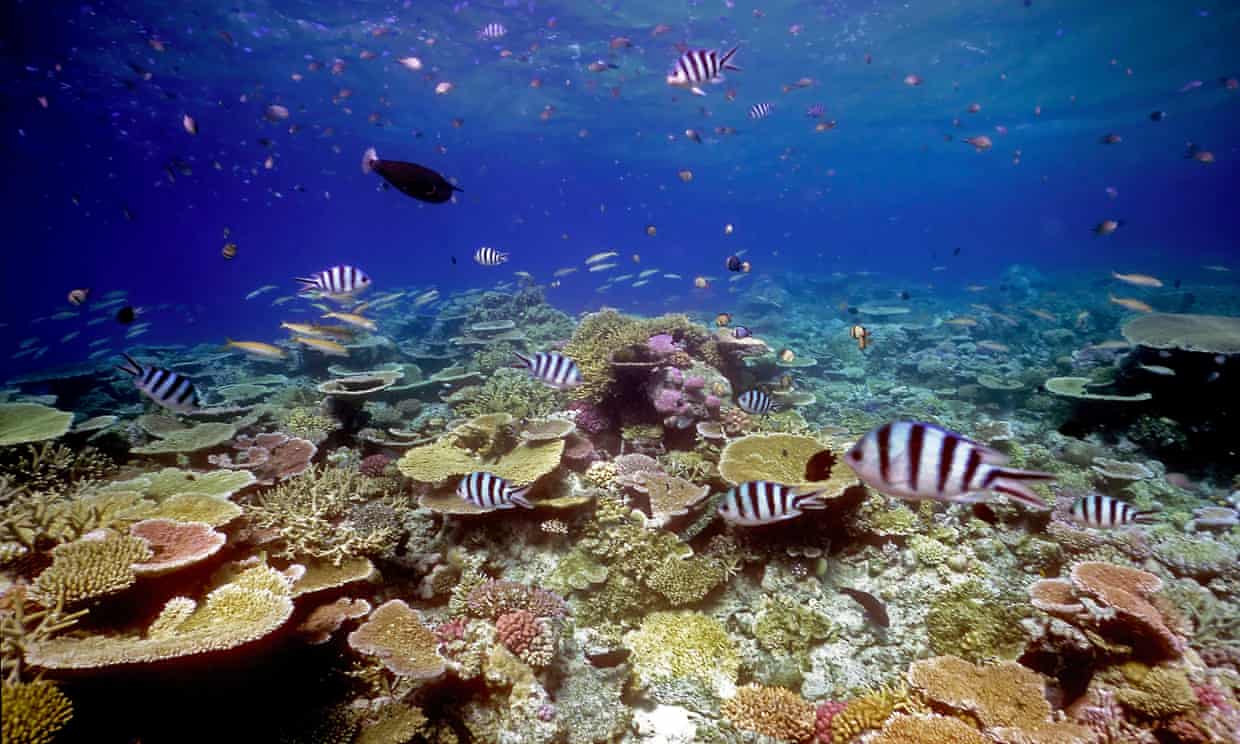
Healthy coral sounds lure fish back to abandoned reefs, study finds
by Nicola DavisWith global heating damaging corals worldwide, experts find potential tool in ‘acoustic enrichment’ to recolonise reefs
Playing sounds of a healthy coral reef can attract fish back to reefs that have become degraded and abandoned, researchers have found.
Global heating together with factors such as pollution are causing widespread damage to coral and harming delicate reef ecosystems.
Reefs offer a home to a plethora of fish species, some of which play roles including cleaning the reef and recycling nutrients. However, previous research has shown degraded reefs sound and smell less attractive to young fish, meaning populations around them dwindle in what scientists fear could be a negative spiral to silence.
But now experts said they have found a way to entice young fish back to degraded reefs, offering a way to potentially speed their recovery.
“[We thought] if one of the things that a degraded reef is missing is its sounds, well, that is something that on a local level we can replace and if we do we might pull in some fish and we might kickstart a recovery a little quicker,” Tim Gordon, first author of the latest study from the University of Exeter, told the Guardian.
Writing in the journal Nature Communications, the researchers reported how they created 33 patches of dead coral rubble and placed these at locations around Australia’s northern Great Barrier Reef in water a few metres deep.
On 11 of the patches, the team played the sounds of a healthy reef at night through loudspeakers, starting shortly before sunset and ending just after sunrise – when fish are known to turn up and settle at reefs.
Healthy reefs, said Gordon, are bustling places. “The first thing that strikes you is this really loud crackle sound – it is almost like static on the radio, or some people describe it like frying bacon, and that is the sound of thousands and thousands of snapping shrimp, all clicking their claws,” he said, adding that fish make noises ranging from grunts to hums, buzzes and whoops.
On the other 22 patches no sounds were played – although in half of these a dummy speaker was present.
After 40 days, the team deconstructed the patches and looked at the fish living on the coral rubble. The results revealed that there were twice as many young fish living on the patches where the sounds were played than in either type of patch without such sounds, while the diversity of species was 50% greater where recordings were played.
What’s more, the team found the influx of fish came from every level of the food chain, from those that eat seaweed to those that prey on other fish – something Gordon said is important, since the different types play different roles on a coral reef.
The researchers said the recordings could be helping to lure young fish to the degraded reefs either by making fish aware that the reef is there, or by making it more likely that fish will settle there once they turn up.
While they said there is more work to do, including unpicking which particular sounds might be behind the effect, whether different sounds might be needed for different reef habitats, and how sounds might affect adult fish, they said the approach has promise in speeding up reef recovery – although it should be combined with other techniques to boost the habitat.
Gordon stressed the importance of tackling the original source of reef damage, whether from warming oceans or blast fishing.
“It is very important to be realistic about this – this is potentially a useful tool for attracting fish towards areas of degraded habitat but it is not a way of solving the coral reef crisis; it is not a way of bringing back a whole reef to life on its own,” he said.
Dr Catherine Head of the Zoological Society of London and the University of Oxford, who was not involved in the study, agreed: “Using acoustic enrichment to help recolonise degraded reefs with essential reef fish is a novel tool which can add to the reef conservation toolbox,” she said.
But, she added: “Our biggest tool in the fight for coral reefs is the 2016 Paris climate change agreement to curb global CO2 emissions, and we must continue to put pressure on governments to fulfil this agreement alongside doing our bit to reduce our own carbon footprints.”